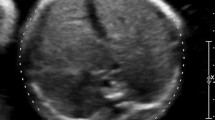Abstract
Purpose
Fetuses with persistent cloaca are known to develop urine or meconium backflow into the abdominal cavity caused by obstruction of the common channel, thus leading to fetal peritonitis with fetal ascites. We analyzed the impact of prenatal fetal ascites on postnatal clinical features and management.
Methods
This retrospective single-center cohort study was conducted to compare the perinatal parameters of patients with isolated persistent cloaca who were born and treated at our hospital between 1991 and 2021. The clinical features and management of those with and without fetal ascites were compared.
Results
Among the 17 eligible patients, fetal ascites were recognized in seven. The occurrence of fetal ascites was significantly related to preterm birth, higher birth weight z-score, birth via emergency cesarean delivery, low Apgar scores at 1 min and 5 min, higher C-reactive protein levels at birth, longer duration of oxygen administration, the need for a urinary drainage catheter at initial discharge, and shorter neonatal hospital stays.
Conclusions
The postnatal management of patients with persistent cloaca with fetal ascites differed significantly from that of patients without fetal ascites. For patients with unexplained fetal ascites, magnetic resonance imaging may be helpful for determining the definite diagnosis of persistent cloaca.
Similar content being viewed by others
References
Levitt MA, Peña A (2010) Cloacal malformations: lessons learned from 490 cases. Semin Pediatr Surg 19:128–138. https://doi.org/10.1053/j.sempedsurg.2009.11.012
Peiro JL, Scorletti F, Sbragia L (2016) Prenatal diagnosis of cloacal malformation. Semin Pediatr Surg 25:71–75. https://doi.org/10.1053/j.sempedsurg.2015.11.004
Morikawa M, Yamada T, Cho K, Yamada H, Minakami H (2006) Prenatal diagnosis and therapy of persistent cloaca: a case report. Fetal Diagn Ther 21:343–347. https://doi.org/10.1159/000092463
Warne S, Chitty LS, Wilcox DT (2002) Prenatal diagnosis of cloacal anomalies. BJU Int 89:78–81. https://doi.org/10.1046/j.1464-4096.2001.01851.x
Nigam A, Kumar M, Gulati S (2014) Fetal ascites and hydrometrocolpos due to persistent urogenital sinus and cloaca: Aa rare congenital anomaly and review of literature. BMJ Case Rep. https://doi.org/10.1136/bcr-2013-202231
Adams MC, Ludlow J, Jw B, Rink RC (1998) Prenatal urinary ascites and persistent cloaca: risk factors for poor drainage of urine or meconium. J Urol 1998:2179–2181. https://doi.org/10.1097/00005392-199812010-00078
Petrikovsky BM, Walzak MP Jr, D’Addario PF (1988) Fetal cloacal anomalies: prenatal sonographic findings and differential diagnosis. Obs Gynecol 72:464–469
Cilento BG Jr, Benacerraf BR, Mandell J (1994) Prenatal diagnosis of cloacal malformation. Urology 43:386–388. https://doi.org/10.1016/0090-4295(94)90086-8
Ogawa R, Kido T, Nakamura M, Kido T, Mochizuki T, Sugiyama T (2018) Magnetic resonance assessment of fetal lung maturity: comparison between signal intensity and volume measurement. Jpn J Radiol 36:444–449. https://doi.org/10.1007/s11604-018-0745-0
Rittenberg MH, Hulbert WC, Snyder HM 3rd, Duckett JW (1998) Protective factors in posterior urethral valves. J Urol 140:993–996. https://doi.org/10.1016/s0022-5347(17)41908-2
Lundar L, Aksnes G, Mørkrid L, Emblem R (2019) Prenatal extravasation of urine seems to preserve renal function in boys with posterior urethral valves. J Pediatr Urol 15:241.e1-241.e7. https://doi.org/10.1016/j.jpurol.2019.02.010
Patil KK, Wilcox DT, Samuel M, Duffy PG, Ransley PGGR (2003) Management of urinary extravasation in 18 boys with posterior urethral valves. J Urol 169:1508–1511
Capito C, Belarbi N, PayeJaouen A, Leger J, Carel JC, Oury JF, Sebag G, El-Ghoneimi A (2014) Prenatal pelvic MRI: additional clues for assessment of urogenital obstructive anomalies. J Pediatr Urol 10:162–166. https://doi.org/10.1016/j.jpurol.2013.07.020
Bischoff A, Levitt MA, Lim FY, Guimarães C, Peña A (2010) Prenatal diagnosis of cloacal malformations. Pediatr Surg Int 26:1071–1075. https://doi.org/10.1007/s00383-010-2685-3
Ishibashi M, Tanaka H, Ito M, Uketa E, Mori E, Hanaoka U, Kanenishi K, Hata T (2013) Antenatal three-dimensional sonographic diagnosis of persistent cloaca. J Med Ultrason 40(3):275–277. https://doi.org/10.1007/s10396-012-0423-2
Khuja M, Nouri A, Wilczyński J, Dzieniecka M, Grzesiak M, Podciechowski L, Finken D, Majos A, Stefańczyk L, Nowakowska D (2011) Clinical challenges in the management of a prenatally diagnosed cloacal malformation. Congenit Anom 51(2):92–95. https://doi.org/10.1111/j.1741-4520.2010.00292.x
Chen CP, Llu FF, Jan SW, Chang PY, Lin YN, Lan CC (1996) Ultrasound-guided fluid aspiration and prenatal diagnosis of duplicated hydrometrocolpos with uterus didelphys and septate vagina. Prenat Diagn 16:572–576. https://doi.org/10.1002/(SICI)1097-0223(199606)16:6%3c572::AID-PD913%3e3.0.CO;2-S
Acknowledgements
We would like to thank Editage (www.editage.com) for English language editing. This work was supported by Masanori Nishikawa, Chief Director of Department of Radiology.
Funding
The authors did not receive support from any organization for the submitted work.
Author information
Authors and Affiliations
Contributions
All authors contributed to the conception and design of the study. Data collection and analysis were performed by all authors. The first draft of the manuscript was written by TY. The draft was reviewed and edited by NU, and all authors commented on the second version of the manuscript. All authors read and approved the final manuscript.
Corresponding author
Ethics declarations
Conflict of interest
The authors have no conflict of interest to declare.
Ethics approval
Approval for this study was obtained from the institutional review board of Osaka Women’s and Children’s Hospital (protocol no. 1459). The procedures used during this study adhered to the tenets of the Declaration of Helsinki.
Consent to participate
The requirement for signed informed consent was waived because of the retrospective study design and the use of de-identified data. Details of the study were published on an institutional website, and individuals had the right to decline participation.
Additional information
Publisher's Note
Springer Nature remains neutral with regard to jurisdictional claims in published maps and institutional affiliations.
Rights and permissions
Springer Nature or its licensor holds exclusive rights to this article under a publishing agreement with the author(s) or other rightsholder(s); author self-archiving of the accepted manuscript version of this article is solely governed by the terms of such publishing agreement and applicable law.
About this article
Cite this article
Yamamichi, T., Sakai, T., Yoshida, M. et al. Persistent cloaca with fetal ascites: clinical features and perinatal management. Pediatr Surg Int 38, 1577–1583 (2022). https://doi.org/10.1007/s00383-022-05204-0
Accepted:
Published:
Issue Date:
DOI: https://doi.org/10.1007/s00383-022-05204-0




